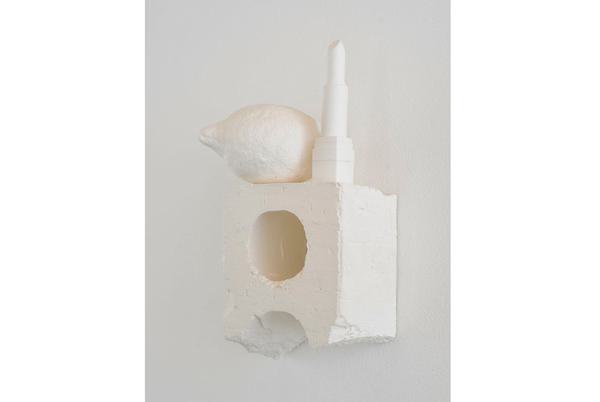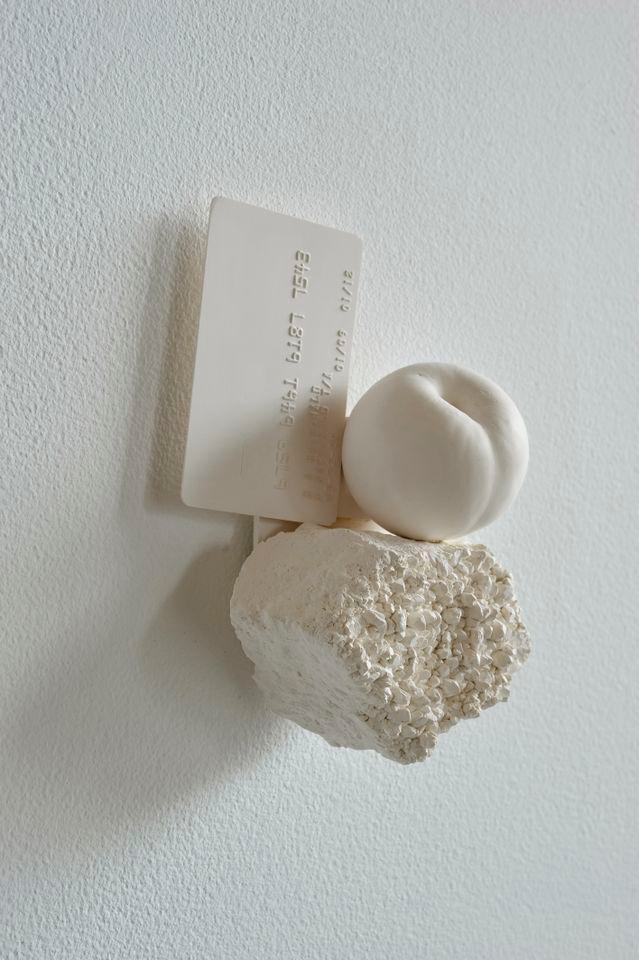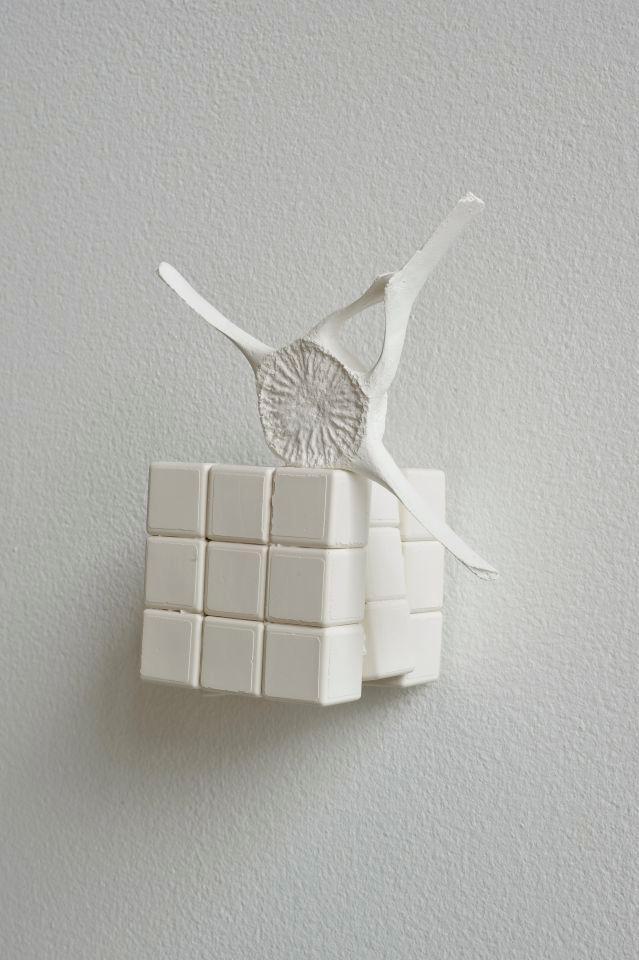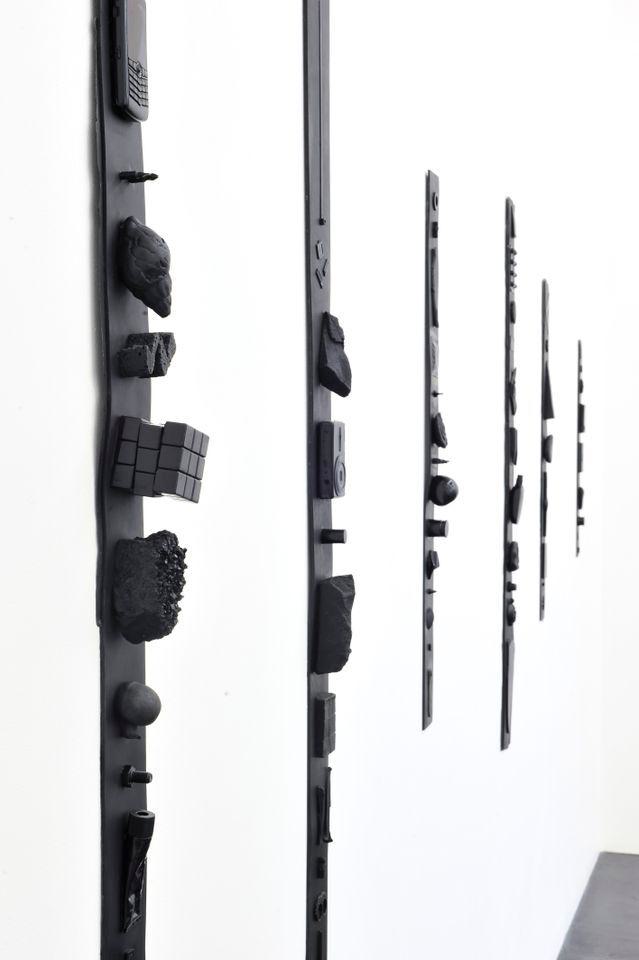Niall Macdonald selected by Claire Jackson (2013)

Niall Macdonald, LIPSTICK LEMON BRICK, 2012 Courtesy of the artist, Kendall Koppe, Glasgow. Photo: Stephen Robinson
Claire Jackson, visual art curator at Tramway, Glasgow, profiles the recent work of Scottish artist Niall Macdonald.
Niall Macdonald creates sculptures of almost surgical precision, through a painstaking process of moulding and casting found objects in a variety of materials including plaster, jesmonite and rubber. Employing the strategies of bricolage, Macdonald's sculptures juxtapose the detritus from our commodity-driven culture with ancient fossils, natural forms from his Hebridean home and the remnants of lost civilizations. The artist excises these fragments from their cultural, social and physical situations and then casts them as multiples in neutral materials, using a refined and labour- intensive process which renders the objects in precise detail.
The moulding technique, which uses silicone to create an impression of even the minutest of surface details, could be likened to the casting equivalent of 'high definition' by replicating the object with an almost hyper-real clarity. These ghostly doubles are then carefully orchestrated over time in the artist’s studio resulting in delicate assemblages of two or more objects, such as the recent works, ‘CREDIT-CARD PLUM AMETHYST’ (2012) and ‘DIGITAL CAMERA-PLIERS’ (2012).

Niall Macdonald, CREDIT-CARD AMETHYST PLUM, 2012, plaster Courtesy of the artist, Kendall Koppe, Glasgow. Photo: Stephen Robinson
Macdonald’s sculptures seem to function compositionally as still life, juxtaposing images of fruit, fossils, food and fabric that remind us of a state of ritual underpinning our experience of everyday objects. However through the process of replication, the work does more than simply translate a painterly language in to a sculptural one; it inhabits a language and plays with its structure and meaning. The detail and subtleties of the cast surface make us reconsider the original object and, in turn, the origin of its production and the culture to which it belonged: a decade-old ecstasy pill, a Roman coin, a Kodak disposable camera, a Rubik’s cube. Macdonald transforms these obsolete objects into timeless fossils, rendering each at a similar scale and in the same luminous, white plaster or high shine, black rubber - devices which elevate their status as art objects, whilst simultaneously stripping them of their distinctions in terms of material and colour.
Such formal strategies, whilst emptying the objects of their material status, have a democratising or levelling effect. These pristine replicas, rendered crisper, sharper, more 'in focus' than the originals, begin to function as metonyms or stand-ins for the cultures and historical narratives to which they belong. Thus, Macdonald subtly reveals the extent to which meaning is embedded in form and how our relationships to certain objects are fundamentally inscribed in our daily lives.
Macdonald mimics the systematic arrangements of museum displays in which collections, series and multiplicity are used to set up a common narrative between objects. Such notions of museological display tend to present cultures as coherent wholes, a monolithic notion which is now subject to constant reorientation through advances in archaeology, technology, research and science. These re-readings of historical narratives in turn allow for new readings of the object. Objects now exist in multiple sites simultaneously, as an image in a book, film or circulated on the internet, contextualised by means of labels, diagrams, commentary, explanatory audiovisual programmes, lectures and performances. As such we have an almost hallucinogenic relationship to them, and it is these spectral and virtual properties of the object which Macdonald's sculptures conjure up.

Niall Macdonald, WHALE-BONE RUBIKS-CUBE, 2012, plaster. Courtesy of the artist, Kendall Koppe, Glasgow. Photo: Stephen Robinson
Modes of museological classification and framing are further referenced and subverted in the upper case titles such as ‘LIPSTICK LEMON BRICK’ (2012), and the formal display of the works. Macdonald situates his sculptures slightly lower than eye level, forcing us to peer at the objects close up and in all their forensic detail, as though through the glass of a museum cabinet. When situated within the gallery space, the white plaster sculptures attain certain invisibility in the space through the very nature of their display. The shiny surfaces and slick contours of works such as ‘PERFUME SPANNER SOCKET’ (2012) hint at our fetish for product design and new technology, Apple’s iPhone being a prime example, whist works such as ‘WHALE-BONE RUBIK’S-CUBE’ (2012) contain once- cult and now obsolete or 'retro' objects which take us on a nostalgic trip to a pre-digital era.
There is an air of melancholy and ‘memento mori’ in these objects - Macdonald's choice of objects seems deliberately to reference obsolescence and how rapid and in many cases predetermined it has become. Certain works force us directly to confront the processes of manufacture and consumption, subtle details becoming signifiers of mass production on a global scale. In this context, a manufacturer’s stamp appears as an almost brutal reference to the factory environment; the perfectly replicated surface of a lemon seems to suggest genetically engineered fruit; a credit card and an old coin affixed to a calculator evoke the shift towards digital forms of economy and exchange, whilst the logos of designer cars and fashion brands suggest the current obsession with lifestyle and consumer desire.

Niall Macdonald, AMMONITE KITKAT, 2012. Installation view, Kendall Koppe, Glasgow, 2012. Courtesy of the artist, Kendall Koppe, Glasgow. Photo: Stephen Robinson
n an empty white gallery space, the sculptures seem to compound these references: works such as ‘AMMONITE KIT-KAT’ (2012) are barely visible in the empty space until up close, becoming part of the architecture of display. Here the artist seems to be mirroring the concepts of ‘anti-monumentalism’ adopted by Minimalist sculptors. Macdonald similarly presents us with sculptures that do not demand our attention but capture it, much like everyday the objects that form the basis of his art.
Claire Jackson, visual art curator, Tramway, Glasgow, 2013
About Niall Macdonald
Niall Macdonald (b.1980, Outer Hebrides of Scotland) graduated form Glasgow School of Art MFA and lives and works in Glasgow. He is represented by Kendall Koppe, Glasgow. Recent exhibitions include Petrosphere, Glasgow International festival of Visual Art 2012, AMMONITE KITKAT, Kendall Koppe Glasgow, REMAP, Athens Greece (2011), UNCUT/NORMAL TIME AT THE 75TH MERIDIAN (with Rallou Panagiotou), + 44 141 Gallery, Glasgow (2011), LEVI HANES/PASSENGER, La Bete, Glasgow, (curated by Niall Macdonald, 2010), NEAR NO RITUAL, Washington Garcia Gallery, Glasgow (2009), ROAR, Bargehouse, London (2009), THINGS WORTH KNOWING, Enderz, London (2009), SALEM, Castlefield Gallery, Manchester (2008) and AND SO IT GOES, Artnews Projects, Berlin (2008).
About Claire Jackson
Claire Jackson is the visual art curator at Tramway, Glasgow, where she has curated a number of exhibitions and events with international and emergent artists since 2008. During her time at Tramway Claire has initiated significant research into the development of interdisciplinary strands of programming, including a number of residencies and events in Tramways theatre spaces and an annual festival of artists moving image in collaboration with LUX, London. Prior to Tramway, between 2001 and 2008, Claire worked as a curator and producer at the ICA London, CCA Glasgow, NVA Glasgow, Glasgow International Festival and The Modern Institute, Glasgow. Since joining Tramway in 2008 Claire has developed and produced solo exhibitions and performances with Pablo Bronstein, Sebastian Buerkner, Christoph Buchel, Dexter Sinister, Duncan Campbell, Tony Conrad, Phil Collins, Redmond Entwistle, Nick Evans, Lara Favaretto, Jannis Kounellis, Hilary Lloyd, Kelly Nipper, Paulina Olowska, Lili Reynaud-Dewar, Yvonne Rainer, James Richards, Corin Sworn, Cara Tolimie, Joanne Tatham and Tom O’Sullivan, Cerith Wyn Evans and Throbbing Gristle. Upcoming projects include a major solo exhibition of work by artist and film maker Steven Sutcliffe.
These biographies were written in 2013 as part of the Open Frequency programme. For the most current information, please visit:
Open Frequency (2004–2014)
This profile was part of Open Frequency, an Axis programme that highlighted emerging developments in contemporary art practice across the UK. Artists were selected and profiled by leading curators, artists, and writers, offering unique insights into the practices shaping contemporary art at the time. These archives remain a valuable resource for understanding the trajectory of some of the most exciting artists of the period.
Helping Artists Keep Going
Axis is an artist-led charity supporting contemporary visual artists with resources, connection, and visibility.


